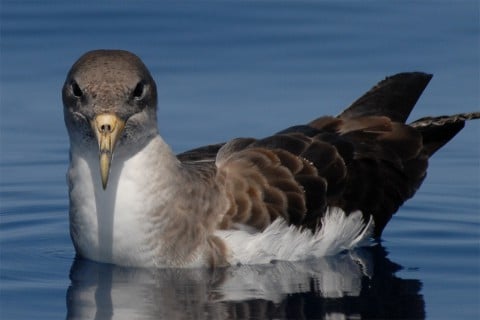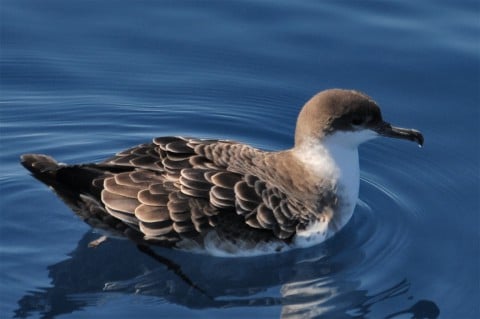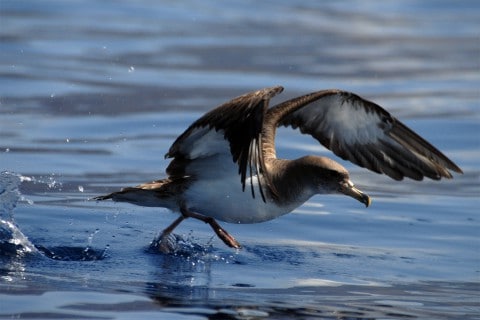Seabirds spontaneously make you think of seagulls. Almost … Real seabirds, such as the shearwaters, which are common here, can stay at sea all the time without getting into trouble with the salt.

The order of tubular noses or Procellariformes includes, for example, albatrosses, shearwaters, petrels and stormpetrels. All members of this order are able to concentrate and excrete salt with one organ at the base of the beak. This enables them to feed completely at sea. The newly fledged young birds spend the first few years at sea accordingly. Only for breeding do they return to the coast later to lay their eggs in caves in inaccessible cliffs.
During a boat trip on the open water or a view of the sea through binoculars you will mainly be able to observe the Cory’s shearwater (in more recent descriptions sepia shearwater, Calonectris diomedea borealis). Here this bird species is called “Pardela cenicienta”, or “Guañaguaña”. About 30,000 pairs are said to nest in the Canary Islands.
They elegantly glide directly above the water surface or use the winds between the waves to surf on them. They primarily hunt small sea creatures (such as flying fish) in the open sea. Especially when they are pushed against the surface barrier from below by dolphins or predatory fish, the birds come down into the water from above and dive for them.

Before sunset, they gather in large numbers in groups to form so-called “rafts” (balsas) and then after dark they fly to their roosts in the cliffs and gorges where their breeding colonies are located. Then you can hear the ghostly sounds of these animals and make out the bright silhouettes against the dark night sky.
The Yellow-billed Shearwater, which is about 45 – 50 cm in size (wingspan 115 cm) and weighs up to 800 grams, hatches one chick each in its cave nests in inaccessible cliffs. For brood care, the parents alternate in a rhythm of several days to a week. The hunting parents usually fly to the African coast to feed in the rich upwelling zones.

At the end of October and the beginning of November, the young birds fly, after their parents have returned to the sea a month earlier. The young, covered with a thick layer of lard, stay behind in the cliff and make their way independently to the water, probably when hunger drives them. Many reach the sea only after several attempts to fly and land, probably often blinded by bright light, in hotel complexes and on streets where cats or cars may pose unknown dangers.
Between October and November, our shearwaters migrate to the South Atlantic to spend the winter there (shearwaters’ flight routes). From February onwards they can be heard again with their characteristic cry.
During the long flight phases, both on food flights and on the long journeys to the south, shearwaters and other seabirds depend on continuous winds to be able to work with less energy in gliding. They also need to be able to rest in flight, which is why it is believed that they are able to work in so-called “interhemispheric sleep” with only one hemisphere of the brain at a time. The other half can be shut down and rest, so to speak.
As shearwaters feed on anything that stays or drifts on the surface, they are particularly vulnerable to large concentrations of plastic waste: they eat plastic, which then accumulates in their stomachs and starve to death.

Other species
Apart from the Cory´s Shearwater, the Manx shearwater (Puffinus puffinus) can still be observed with a certain degree of regularity. They have a dark grey beak and a bright “chin”. Even rarer is the Great Shearwater, (Puffinus gravis o Ardenna gravis), where the separation into a dark cap and a light-coloured underside of the head is even more pronounced.
The Little Shearwater (Puffinus assimilis) is much smaller, the bill is almost black, otherwise it resembles the Great Shearwater.
You can also meet various other species from the family of petrels and storm petrels at sea. The Bulwer’s petrel (Bulweria bulwerii) is completely dark in colour and is associated here with the souls of the dead sailors: “Almamaestre” (soul of the captain/chief). Dramatically good, as only a black soul can be, it surfs artistically on the upwinds between the waves, especially in strong winds.
The way of life of the seemingly fragile, less than blackbird-sized storm petrels is no longer tangible for us: these small birds spend the first 2 years of their lives completely on the water and can cope with the most adverse weather conditions in the vast expanse of the ocean. When the wind is not so strong, you can watch them directly above the surface, “walking” with their feet on the water to bring up plankton, which they then pick up. This has also earned them the name of wave runners.

The only species breeding on La Gomera is the European storm petrel (Hydrobates pelágicus). In 2001, the population of La Gomera was estimated at 50 pairs (in 1993 it was estimated at 1000 pairs in the Canary Islands). In addition, the Madeiran storm petrel (Oceanodroma castro, 600 pairs estimated in 2011) or the much brighter white-faced storm petrel (Pelagodroma marina), 50-70 pairs on the islands in the north of Lanzarote, still breed in the Canary Islands.
Threads

All the birds in this group have three main problems in addition to the plastic flood mentioned above.
Light pollution: The lighting systems that are becoming more and more widespread in inhabited coastal areas either lure the birds to a “luminous” prey (bioluminescence in squid) or disorientate them.
Built-up coastal landscapes destroy the habitat.
Introduced predators such as rats and cats make life difficult for them. This goes so far that the smaller species such as petrels and storm petrels can only breed on offshore islets for this reason.
Bibliography:
Aves del archipiélago Canario. Aurelio Martín y Juan Antonio Lorenzo. Francisco Lemus editor, 2001.
https://www.canariasdiario.com/la-gomera-activa-la-campana-de-recogida-de-la-pardela-cenicienta
https://www.researchgate.net/publication/313270515_Seabird_mortality_induced_by_land-based_artificial_lights
Gallery:




